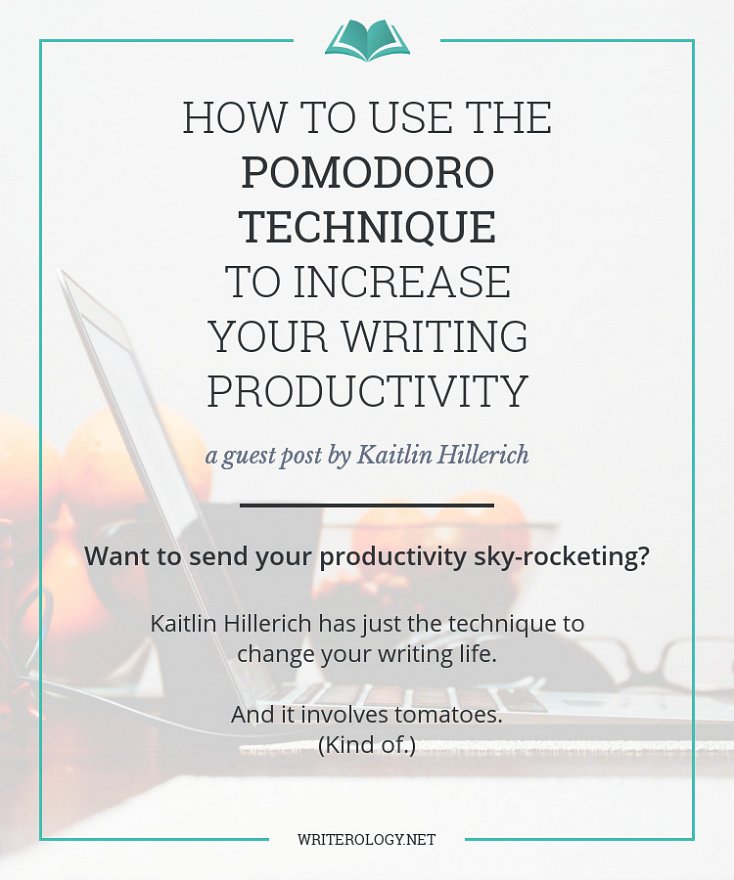How to Use the Pomodoro Technique to Increase Your Writing Productivity
Want to send your productivity sky-rocketing? My guest today, the wonderful Kaitlin Hillerich, has just the technique to change your writing life. Over to you, Kaitlin.

Recently, I discovered the Pomodoro technique and let me tell you—it has changed my writing sessions for the better.
“The Pomo-what?” you ask.
Yeah, I know, that’s what I said the first time I heard it. Apparently pomodoro is Italian for tomato, and the technique gets its name from a kitchen timer of the same shape. But what do tomatoes have to do with writing?
The Pomodoro Technique is a time management strategy that breaks down a large work session into 25 minute chunks, with five minute breaks in-between. After four pomodoros (work sessions), you earn a longer, 10-15 minute break. A timer is used to keep track of the work sessions and breaks. Since I’ve been using this technique I’ve seen an increase in my focus and productivity during writing sessions.
As soon as I turn on the timer on my Pomodoro app, it’s like a switch flips in my brain. I suddenly become super focused because I know that in twenty five minutes, that buzzer is going to ring so I need to get as much done as I can. Seeing the timer creates both a sense of urgency and a challenge. It helps me get into the mindset of this being a time to work because I know that after the twenty five minutes I will be rewarded with my break.
Before I started using this technique I would take breaks whenever I felt like it, which wasn’t always necessarily when I was tired. I would let myself become distracted and hop on the internet whenever I was stuck on a scene or simply didn’t feel like writing. This led to a writing session filled with lots of frequent breaks, and these breaks would often last far longer than they should have. Which meant I was getting far less accomplished in my writing sessions than I could have been!
The Pomodoro technique allows for two five-minute breaks during a one hour writing session. I’ve found that this is a perfect balance—the breaks are long and frequent enough to keep me from getting burnt out while writing, which means I can write longer, and they’re short and limited enough to keep me from wasting time. I’ve also found that the timer is a huge key to maintaining my break time. During my breaks, I’ll browse Twitter or Pinterest and it’s easy to lose track of time and become distracted. But when the buzzer goes off there’s no forgetting, and I have that urgency of the timer counting down to encourage me to get back to work.
The timer helps keep my writing sessions organized and on track without me constantly having to check the clock.
I’ve experimented with using the Pomodoro technique without the timer element, and I’ve found that it just doesn’t have the same effect. First, it’s too easy to get distracted during writing or breaks sessions and lose track of time. Second, not having the urgency and accountability of the timer doesn’t produce the same results. Without the timer, I know there’s no buzzer that will be going off to hold me accountable for my break, so what does it matter if I take ten minutes instead of five? The timer helps keep my writing sessions organized and on track without me constantly having to check the clock, and helps me to stay motivated.
Ready to try the Pomodoro technique for yourself? The easiest way to get started is to download a Pomodoro timer app on your phone. There are several options to choose from in both the free and paid categories. Once you start implementing the Pomodoro technique and see how your productivity, focus, and motivation increase, you’ll never look back.
Who knew tomatoes could be so beneficial to writing?
Want to read more articles from knowledgeable guests? Pop on over to the Guest Writerologist archives and explore.